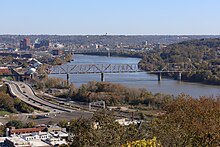You can help expand this article with text translated from
the corresponding article in German. (January 2024) Click [show] for important translation instructions.
|



The Cincinnati Southern Bridge, originally the Cincinnati Southern Railroad Swinging Truss Bridge, is a vertical lift bridge that carries the Norfolk Southern Railway's Cincinnati, New Orleans and Texas Pacific Railway over the Ohio River between Cincinnati, Ohio, and Ludlow, Kentucky in the United States.
The bridge is composed of four through truss spans: a main span on the northern side of the bridge, a currently unused vertical lift span on the southern side, and two additional spans over the main shipping channels in the center of the bridge. The bridge crosses the Ohio River just downstream from downtown Cincinnati, and can be seen clearly from the lower level of the nearby Brent Spence Bridge.
History
The Cincinnati Southern Railway Bridge was begun in 1875; construction was completed in December, 1877, and the bridge immediately opened to traffic. Its cost exclusive of right of way was $811,683. [1] The 519-foot (158 m) truss bridge was the longest bridge of its type when it was completed. [2]
It was extensively modernized in 1922, and it remains the busiest railroad bridge in the city of Cincinnati today. The modernization replaced a swing span with a vertical lift span that was designed to rise only 13 feet. [3] That was all that was considered necessary for clearance during periods of high water. The span was visually unique in that the swing pier from the original structure was left in place even though it was no longer physically connected to the bridge. Since 1976, the bridge's vertical lift span has been abandoned in its closed position, forcing all ships to pass under the center truss spans. For tall ships, the bridge marks the end of their Ohio River voyage.
See also
References
- ^ Kenny, Daniel J. (1895). Illustrated Guide to Cincinnati and the World's Columbian Exposition. R. Clarke. p. 23. Retrieved 2013-05-22.
- ^ Goodman, Rebecca (2005). This Day in Ohio History. Emmis Books. p. 218. ISBN 9781578601912. Retrieved 21 November 2013.
- ^ "Cincinnati Southern Railroad Bridge - HistoricBridges.org".
External links
- Cincinnati Southern Bridge at Bridges & Tunnels
39°05′53″N 84°32′31″W / 39.098036°N 84.542043°W
- Railroad bridges in Kentucky
- Railroad bridges in Ohio
- Bridges in Cincinnati
- Bridges over the Ohio River
- Norfolk Southern Railway bridges
- Southern Railway (U.S.)
- Truss bridges in the United States
- Swing bridges in the United States
- Metal bridges in the United States
- United States railway bridge stubs
- Southern United States bridge (structure) stubs
- Kentucky building and structure stubs
- Kentucky transportation stubs
- Midwestern United States bridge (structure) stubs
- Ohio building and structure stubs
- Ohio transportation stubs
You can help expand this article with text translated from
the corresponding article in German. (January 2024) Click [show] for important translation instructions.
|



The Cincinnati Southern Bridge, originally the Cincinnati Southern Railroad Swinging Truss Bridge, is a vertical lift bridge that carries the Norfolk Southern Railway's Cincinnati, New Orleans and Texas Pacific Railway over the Ohio River between Cincinnati, Ohio, and Ludlow, Kentucky in the United States.
The bridge is composed of four through truss spans: a main span on the northern side of the bridge, a currently unused vertical lift span on the southern side, and two additional spans over the main shipping channels in the center of the bridge. The bridge crosses the Ohio River just downstream from downtown Cincinnati, and can be seen clearly from the lower level of the nearby Brent Spence Bridge.
History
The Cincinnati Southern Railway Bridge was begun in 1875; construction was completed in December, 1877, and the bridge immediately opened to traffic. Its cost exclusive of right of way was $811,683. [1] The 519-foot (158 m) truss bridge was the longest bridge of its type when it was completed. [2]
It was extensively modernized in 1922, and it remains the busiest railroad bridge in the city of Cincinnati today. The modernization replaced a swing span with a vertical lift span that was designed to rise only 13 feet. [3] That was all that was considered necessary for clearance during periods of high water. The span was visually unique in that the swing pier from the original structure was left in place even though it was no longer physically connected to the bridge. Since 1976, the bridge's vertical lift span has been abandoned in its closed position, forcing all ships to pass under the center truss spans. For tall ships, the bridge marks the end of their Ohio River voyage.
See also
References
- ^ Kenny, Daniel J. (1895). Illustrated Guide to Cincinnati and the World's Columbian Exposition. R. Clarke. p. 23. Retrieved 2013-05-22.
- ^ Goodman, Rebecca (2005). This Day in Ohio History. Emmis Books. p. 218. ISBN 9781578601912. Retrieved 21 November 2013.
- ^ "Cincinnati Southern Railroad Bridge - HistoricBridges.org".
External links
- Cincinnati Southern Bridge at Bridges & Tunnels
39°05′53″N 84°32′31″W / 39.098036°N 84.542043°W
- Railroad bridges in Kentucky
- Railroad bridges in Ohio
- Bridges in Cincinnati
- Bridges over the Ohio River
- Norfolk Southern Railway bridges
- Southern Railway (U.S.)
- Truss bridges in the United States
- Swing bridges in the United States
- Metal bridges in the United States
- United States railway bridge stubs
- Southern United States bridge (structure) stubs
- Kentucky building and structure stubs
- Kentucky transportation stubs
- Midwestern United States bridge (structure) stubs
- Ohio building and structure stubs
- Ohio transportation stubs